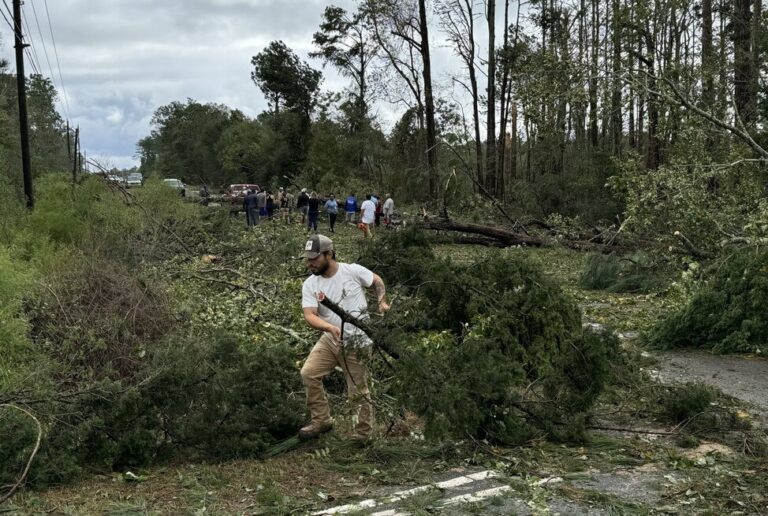When I walked outside of my house just after daylight on September 27, 2024, I wasn’t sure what I would see. I wasn’t sure what I *should* see. The night had been a difficult one. We had endured Hurricane Helene. I had heard – and felt – trees falling through my house. Water was dripping through the ceiling in my kitchen. A large pine tree had punched a hole in the ceiling of my younger son’s bedroom.
As I stepped outside, the neighborhood was a tangled mess of twisted trees, crushed homes, damaged vehicles, downed power lines, and blocked roads. I couldn’t imagine what the rest of the community looked like.
We all know the rest of the story. Helene delivered a knockout blow to Douglas and Coffee County. She continued landing haymakers as she tracked northeast, leaving her calling card of destruction in every community through which she passed. Helene disrupted every aspect of life – communication, work, education, healthcare, public safety, energy, and sanitation.
In the matter of just a few hours, we were transported to an era with which we weren’t familiar – no electricity, no water, no instant communication, no nothing. It was inconvenient. Unpleasant. And, at times, terrifying.
Throughout history, disasters have left their marks on communities, some for over 100 years or more. The Chicago Fire of 1871. The 1906 San Francisco earthquake. The Dust Bowl of the 1930s. 1978’s Love Canal situation in upstate New York. Then of course there are more recent disasters – Hurricanes like Andrew, Michael, Katrina, and the like; the Deepwater Horizon spill; the Exxon Valdez spill; and this year’s Pacific Palisades wildfires. These disasters forever changed the communities in which they most directly affected.
Am I equating Hurricane Helene with the San Francisco earthquake? Not necessarily. However, just like those events altered their communities, so has Helene altered ours. From this point forward, there will never be a discussion regarding Coffee County’s architecture, appearance, or landscape without mentioning Hurricane Helene. “That barn over there – it used to match the house. We lost the old barn during Helene and had to build a new one. That’s why it looks different.” “You see that big empty space over there? We used to have chicken houses but Helene took them out in 2024.” “The peanut field by the pond used to be planted pines. Hurricane Helene knocked down the trees then the timber market tanked after the storm. We decided not to re-plant.” Those are the types of conversations people will be having with their families and friends for decades to come.
We all learned a number of lessons from Helene. We learned the importance of communication, collaboration, unity, cooperation, resilience, toughness, and the refusal to give up. To me, though, the most important lesson to come out of this disaster is the absolute necessity of relationships. When the trees fell, when the roadways were blocked, when the power was out, our phones, devices, and online friends a half a world away weren’t any help. People, not technology, came to the rescue.
Nowhere was this more evident than in the faith community. Churches, denominations, faith-based organizations, and even entire communities descended upon Douglas and Coffee County to lend their resources and talents to the rebuilding effort. Throughout Scripture, believers are commanded to take care of those who can’t take care of themselves. It’s not a job farmed out to government or alphabet agencies; it’s a direct command from the Lord to roll up your sleeves and get involved in the problems of others. It’s not easy and it comes with great risk. But Christians throughout the country answered that call – and are continuing to answer that call – in Coffee County.
Have we recovered? I guess that depends on how you measure recovery. I tend to think of the last year in terms of a rebound – we’ve certainly rebounded but I’m not sure we’ve recovered. True recovery is going to take a long time, a decade or more.
Even though we have returned to our daily routines and the activities that hold our attention, our community remains in a shambles in some places. Forests are gone. Landmarks have been destroyed or permanently altered. Take South Georgia State College, for example. The most significant feature of the campus, maybe even more noticeable than the academic buildings themselves, were the trees. Helene destroyed over 4,000 of those trees. SGSC isn’t going to look the same for 30 years or more – if it ever does.
No, I don’t think we’ve recovered. But eventually, we will. And it will come because of the people in this community and those from other areas who felt the tug at their hearts to get involved.
People, not institutions, are the real difference-makers. We have seen that over the last year and we will continue to see that as recovery carries on.







